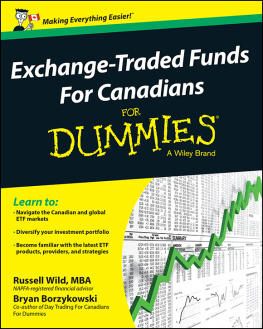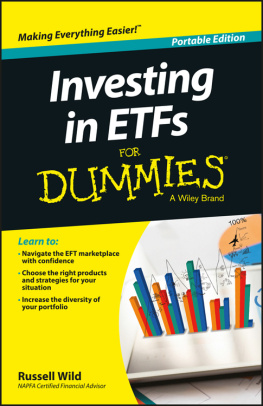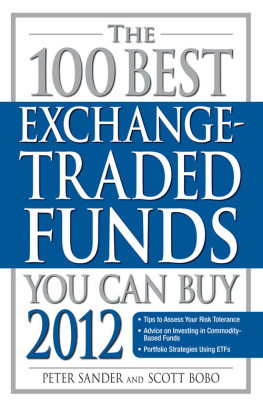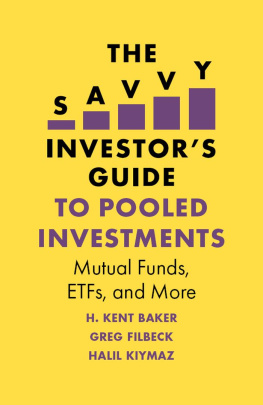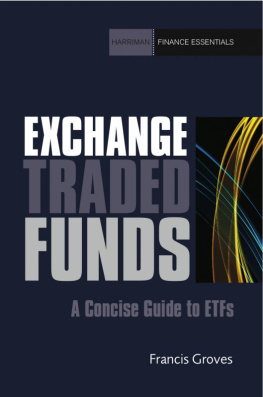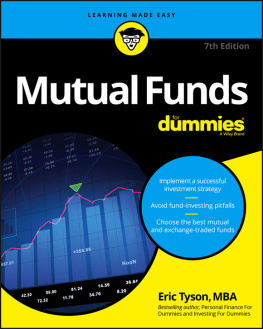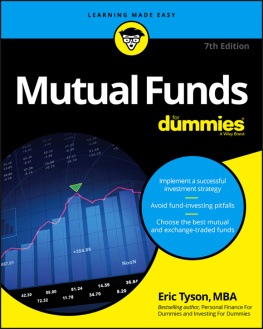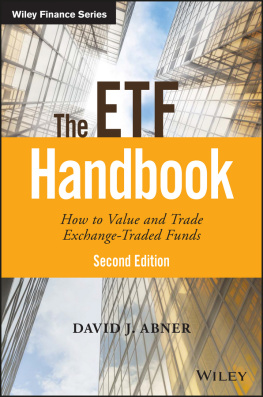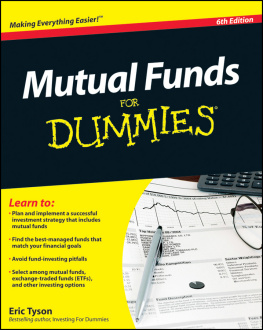
Exchange-Traded Funds For Canadians For Dummies
Published by:
John Wiley & Sons Canada, Ltd.,
6045 Freemont Blvd.,
Mississauga, ON L5R 4J3
www.wiley.com
Copyright 2013 by John Wiley & Sons Canada, Ltd.
No part of this publication may be reproduced, stored in a retrieval system or transmitted in any form or by any means, electronic, mechanical, photocopying, recording, scanning or otherwise, except as permitted under Sections 107 or 108 of the 1976 United States Copyright Act, without the prior written permission of the Publisher. Requests to the Publisher for permission should be addressed to the Permissions Department, John Wiley & Sons Canada, Ltd., 6045 Freemont Blvd., Mississauga, ON L5R 4J3, or online at http://www.wiley.com/go/permissions . For authorization to photocopy items for corporate, personal, or educational use, please contact in writing The Canadian Copyright Licensing Agency (Access Copyright). For more information, visit or call toll free, 1-800-893-5777.
Trademarks: Wiley, For Dummies, the Dummies Man logo, Dummies.com, Making Everything Easier, and related trade dress are trademarks or registered trademarks of John Wiley & Sons, Inc., and may not be used without written permission. All other trademarks are the property of their respective owners. John Wiley & Sons, Inc., is not associated with any product or vendor mentioned in this book.
Limit of Liability/Disclaimer of Warranty: while the publisher and author have used their best efforts in preparing this book, they make no representations or warranties with respect to the accuracy or completeness of the contents of this book and specifically disclaim any implied warranties of merchantability or fitness for a particular purpose. no warranty may be created or extended by sales representatives or written sales materials. The advice and strategies contained herein may not be suitable for your situation. you should consult with a professional where appropriate. neither the publisher nor the author shall be liable for damages arising herefrom.
For general information on John Wiley & Sons Canada, Ltd., including all books published by John Wiley & Sons, Inc., please call our distribution centre at 1-800-567-4797. For reseller information, including discounts and premium sales, please call our sales department at 416-646-7992. For press review copies, author interviews, or other publicity information, please contact our publicity department, Tel. 416-646-4582, Fax 416-236-4448. For technical support, please visit www.wiley.com/techsupport .
Wiley publishes in a variety of print and electronic formats and by print-on-demand. Some material included with standard print versions of this book may not be included in e-books or in print-on-demand. If this book refers to media such as a CD or DVD that is not included in the version you purchased, you may download this material at http://booksupport.wiley.com . For more information about Wiley products, visit www.wiley.com .
Library and Archives Canada Cataloguing in Publication Data
Wild, Russell, author
Exchange-traded funds for Canadians for dummies / Russell Wild,
Bryan Borzykowski.
(For dummies)
Includes index.
Canadian edition of Exchange-traded funds for dummies, c2012.
Issued in print and electronic formats.
ISBN 978-1-118-52457-2 (pbk.).ISBN 978-1-118-52463-3 (epub).
ISBN 978-1-118-52464-0 (mobi).ISBN 978-1-118-52462-6 (pdf)
1. Exchange traded funds. 2. Stock index futures.
I. Borzykowski, Bryan, author II. Title. III. Series: For dummies
HG6043.W44 2013 332.63'27 C2013-903237-1
C2013-903238-X
Printed in the United States of America
10 9 8 7 6 5 4 3 2 1
Introduction
E very month, it seems, Bay Street comes up with some newfangled investment idea. The array of financial products (replete with 164-page prospectuses) is now so dizzying that the old lumpy mattress is starting to look like a more comfortable place to stash the cash. But one relatively new product out there is definitely worth looking at. Its something of a cross between an index mutual fund and a stock, and its called an exchange-traded fund, or ETF.
Just as computers and fax machines were used by big institutions before they caught on with individual consumers, so it was with ETFs. This made-in-Canada product (its true!) was first embraced by institutional traders investment banks, hedge funds, and insurance firms because, among other things, ETFs allow for the quick juggling of massive holdings. Big traders like that sort of thing. During the past several years, millions of North American investors have poured their savings into ETFs mostly U.S.-based ones, but the Canadian market has been gaining steam too.
We like and use ETFs too. They have grown exponentially in the past few years, and they will surely continue to grow and gain influence. While we cant claim that our purchases and recommendations of ETFs account for much of the growing $1 trillion-plus ETF market, were happy to be a (very) small part of it. After youve read Exchange-Traded Funds For Canadians For Dummies, you may decide to become part of it as well, if you havent already.
During the last few years, most of the financial world has been focused on imploding hedge funds, mutual fund redemptions, and Bernie Madofflike swindlers. But one story that should be getting more attention is the rising popularity of ETFs. Thanks to the recession and todays slow-moving market, many folks have ditched their advisors and are now buying these low-cost products. ETFs are almost always cheaper than mutual funds, and they serve as solid building blocks for a diversified portfolio.
But ETFs have gotten a bad rap, too, especially for the role they played in the infamous flash crash of May 6, 2010 (see ), and for the ongoing role they are playing in the increasingly nauseating volatility of the markets. According to one 2010 report from the Ewing Marion Kauffman Foundation, ETFs are choking the recovery and may pose unrecognized risks to the financial markets.
Well, were not so sure about that (especially given that the stock market shot up 10 percent in the six months immediately following the Kauffman report, and the S&P 500 continues to climb today). We discuss the overall effect that ETFs have had on financial markets, but what we concentrate on most in this book is how changes in the ETF market affect you the individual investor. And in that arena, without question, there have been many changes both positive and negative.
One very positive change in the past several years is that investors now have access to ETFs that cover most areas of the market. Half a decade ago, you couldnt buy an ETF that would give you exposure to high-yield bonds. Or international bonds. Or international real estate investment trusts (REITs). All that has changed. ETFs that represent all those asset classes, and many more, now exist. Building an entire well-diversified portfolio out of ETFs was not humanly possible several years ago; it is very possible today.
Another very positive development: ETFs are being used more and more in Registered Retirement Savings Plans (RRSPs) and Tax-Free Savings Accounts (TFSAs), where many of Canadas hard-working people store the bulk of their savings. And theyve been appearing in Registered Education Savings Plans (RESPs), too. Insurance companies have also jumped into the fray, offering ETFs in some of their annuity plans (which, unfortunately, are still often overpriced).

